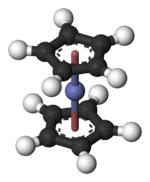
Back كوبالتوسين Arabic کوبالتوسن AZB Cobaltocen German Cobaltoceno Spanish کبالتوسن Persian Kobolttoseeni Finnish Cobaltocène French Kobaltosena ID Cobaltocene Italian コバルトセン Japanese
| |||
| Names | |||
|---|---|---|---|
| IUPAC names
Cobaltocene
Bis(η5-cyclopentadienyl)cobalt | |||
| Other names
Cp2Co
| |||
| Identifiers | |||
3D model (JSmol)
|
|||
| ChEBI | |||
| ChemSpider | |||
| ECHA InfoCard | 100.013.692 | ||
| EC Number |
| ||
PubChem CID
|
|||
| RTECS number |
| ||
| UNII | |||
CompTox Dashboard (EPA)
|
|||
| |||
| |||
| Properties | |||
| [Co(η5-C5H5)2] | |||
| Molar mass | 189.12 g/mol | ||
| Appearance | Dark purple solid | ||
| Melting point | 171–173 °C (340–343 °F; 444–446 K) | ||
| Insoluble | |||
| Structure | |||
| sandwich | |||
| zero | |||
| Thermochemistry | |||
Std molar
entropy (S⦵298) |
236 J K−1 mol−1 | ||
Std enthalpy of
formation (ΔfH⦵298) |
+237 kJ/mol (uncertain) | ||
Std enthalpy of
combustion (ΔcH⦵298) |
−5839 kJ/mol | ||
| Hazards | |||
| GHS labelling: | |||
  [1] [1]
| |||
| Danger[1] | |||
| H228, H317, H351[1] | |||
| P210, P261, P280, P363, P405, P501[1] | |||
| NFPA 704 (fire diamond) | |||
| Safety data sheet (SDS) | External SDS | ||
| Related compounds | |||
Related metallocenes
|
Ferrocene Nickelocene Rhodocene | ||
Except where otherwise noted, data are given for materials in their standard state (at 25 °C [77 °F], 100 kPa).
| |||
Cobaltocene, known also as bis(cyclopentadienyl)cobalt(II) or even "bis Cp cobalt", is an organocobalt compound with the formula Co(C5H5)2. It is a dark purple solid that sublimes readily slightly above room temperature. Cobaltocene was discovered shortly after ferrocene, the first metallocene. Due to the ease with which it reacts with oxygen, the compound must be handled and stored using air-free techniques.
- ^ a b c d "Bis(cyclopentadienyl)cobalt(II)". American Elements. Retrieved 2018-08-24.


